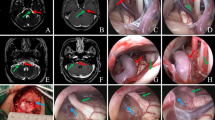Abstract
Background
Microvascular decompression (MVD) is an effective treatment for drug-resistant trigeminal neuralgia and hemifacial spasm. However, failure of symptomatic improvement can arise from difficulties in identifying and/or decompressing the offending vessel. Microscopic and endoscopic techniques have been used to improve visualisation and safety of the procedure but there are limitations to each technique.
Method
A 3D exoscopic endoscope-assisted MVD technique is described, including advice on potential pitfalls.
Conclusion
Compared with the standard microscope-assisted techniques, the 3D exoscopic endoscope-assisted MVD offers an improved visualisation without compromising the field of view within and outside the surgical field.





Similar content being viewed by others
References
Alfieri A, Strauss C, Prell J, Peschke E (2010) History of the nervus intermedius of Wrisberg. Ann Anat 192:139–144
Di Ieva A, Lee JM, Cusimano MD (2015) Handbook of skull base surgery. Thieme, New York
Mercier P, Sindou M (2018) The conflicting vessels in hemifacial spasm: literature review and anatomical-surgical implications. Neurochirurgie 64:94–100
Nagata Y, Watanabe T, Nagatani T, Takeuchi K, Chu J, Wakabayashi T (2017) The multiscope technique for microvascular decompression. World Neurosurg 103:310–314
Piazza M, Lee JY (2016) Endoscopic and microscopic microvascular decompression. Neurosurg Clin N Am 27:305–313
Rak R, Sekhar LN, Stimac D, Hechl P (2004) Endoscope-assisted microsurgery for microvascular compression syndromes. Neurosurgery 54:876–881
Setty P, Volkov AA, D'Andrea KP, Pieper DR (2014) Endoscopic vascular decompression for the treatment of trigeminal neuralgia: clinical outcomes and technical note. World Neurosurg 81:603–608
Zhong J, Zhu J, Sun H, Dou NN, Wang YN, Ying TT, Xia L, Liu MX, Tao BB, Li ST (2014) Microvascular decompression surgery: surgical principles and technical nuances based on 4000 cases. Neurol Res 36:882–893
Acknowledgments
The authors acknowledge Karl Storz Australia for the support with regard to the use of the 3D VITOM exoscope.
Author information
Authors and Affiliations
Corresponding author
Ethics declarations
Conflict of interest
The authors declare that they have no conflict of interest.
Informed consent
Informed consent was obtained from the patient included in the study.
Additional information
Summary of key points
• The combined exoscope-endoscopic technique enhances the operative field of view by its bimodal system and makes inserting or removing instruments from the operative field safer.
• The use of EMG and brainstem evoked potential is recommended.
• The exoscope should be used along each surgical step whenever possible.
• The endoscope is used as an adjunct to enhance visualisation and identification of the offending vessel.
• A post-decompression check can also be performed with the endoscope and confirmed by the use of microscope.
• The nerve should be decompressed along the whole length of the nerve, as multiple areas of compression can be present. Careful pre-operative analysis of the CISS-MRI can help to identify further vascular loops causing cranial nerve compression.
• Teflon pledgets can be kept in place using fibrin sealant at the end of the decompression.
• There is a different learning curve to this technique and the use of the combined approach is recommended for simple procedures when starting out.
• Anatomical training lab is essential for mastering the technique, as well as testing the best ergonomics in terms of positioning of the exoscope and endoscope arms, monitors, etc.
• The endoscope can be used pre- and post-decompression to enhance visualisation of the neurovascular complex.
Publisher’s note
Springer Nature remains neutral with regard to jurisdictional claims in published maps and institutional affiliations.
This article is part of the Topical Collection on Neurosurgical technique evaluation
Electronic supplementary material
Rights and permissions
About this article
Cite this article
Li Ching Ng, A., Di Ieva, A. How I do it: 3D exoscopic endoscope-assisted microvascular decompression. Acta Neurochir 161, 1443–1447 (2019). https://doi.org/10.1007/s00701-019-03954-w
Received:
Accepted:
Published:
Issue Date:
DOI: https://doi.org/10.1007/s00701-019-03954-w




